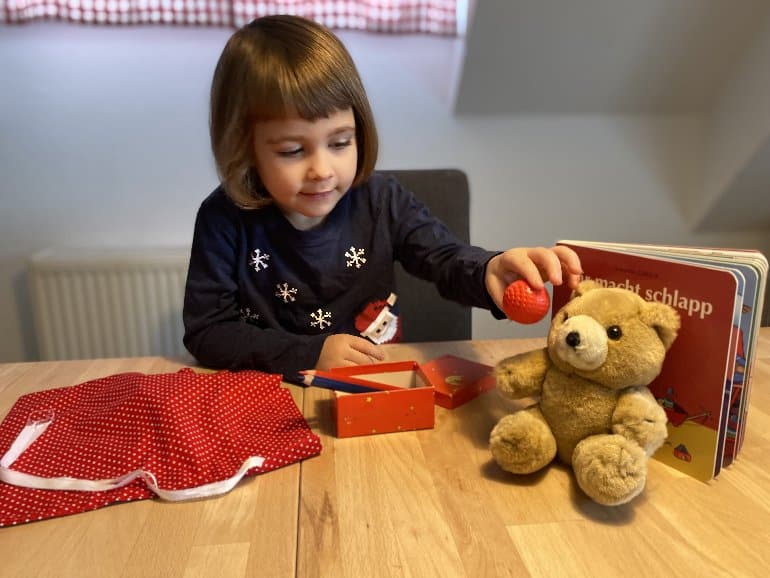Summary: The development of a child’s general and grammatical linguistic abilities between the ages of 3 to 4 is accompanied by the maturation of brain structures within the “language network”.
Source: RUB
Anyone who has ever learned a foreign language knows how laborious it is to acquire vocabulary and grammar. In contrast, children acquire their first language seemingly effortlessly. By the age of four, many children are already speaking without errors and can draw on a large vocabulary.
But how can the brain accomplish this? In a study published in the journal Cerebral Cortex, scientists from MPI CBS now describe that the development of language ability in three- to four-year-olds is accompanied by the maturation of brain areas within the same language network that is also responsible for understanding and producing language in adults.
Grammar is essential to our linguistic understanding. Why? Individual words carry the meaning of the sentence, but it is grammar that puts the words in relation to each other and in their proper place.
In the statement “That the dog the rabbit push,” where only the basic form of the words is used, we might guess that the dog pushed the rabbit. Only when we apply grammatical rules and form the sentence “The dog that the rabbit pushed” from the same words, it becomes clear, exactly the opposite is the case.
Children have to learn these rules first and master them without anyone explaining it to them explicitly.
“By their third birthday, children can already use simpler rules, but it is not until the age of four that they begin to understand and produce more complicated sentences. With our study, we wanted to find out which maturation processes in the brain accompany this milestone in language development,” says Cheslie C. Klein from the Max Planck Institute for Human Cognitive and Brain Sciences in Leipzig.
Together with her colleagues from the Department of Neuropsychology and the research group Milestones of Early Cognitive Development, she studied the grammar level of children between the ages of three and four, both in understanding and speaking sentences, using different language games.
In addition to language ability, an image of the children’s brains was taken in a magnetic resonance imaging (MRI) scanner to determine the maturity of specific brain areas. The researchers observed that the development of the children’s general and grammatical language abilities were accompanied by the maturation of brain structures within the so-called “language network.”
“In adults, it has been repeatedly shown that different brain areas in this network work together to enable language comprehension and production.

“The results of our study show that the maturation of the language network also supports general language and specifically grammar acquisition in children between the ages of three and four,” explains Klein, the first author of the study.
Angela D. Friederici, director of the Department of Neuropsychology at MPI CBS and co-author of the study, highlights, “It was particularly exciting for us to see that the maturation of a specific brain region—which is considered the core region for grammar—was related to the grammar skills of four-year-old children, but not to those of three-year-olds. Children do not learn to understand and produce more complex sentence structures until the age of four.
“So our results suggest that this milestone in language acquisition is only made possible by the support of Broca’s area in the processing of complex grammar. Thus, our findings provide new insight into the neural processes that contribute to successful language development.
“Findings like these are very important because they also provide a better understanding of developmental delays or even disorders in language acquisition.”
About this language and neuroscience research news
Author: Press Office
Source: Max Planck Institute
Contact: Press Office – Max Planck Institute
Image: The image is credited to Max Planck Institute
Original Research: Open access.
“Children’s syntax is supported by the maturation of BA44 at 4 years, but of the posterior STS at 3 years of age” by Cheslie C Klein et al. Cerebral Cortex
Abstract
Children’s syntax is supported by the maturation of BA44 at 4 years, but of the posterior STS at 3 years of age
Within the first years of life, children learn major aspects of their native language. However, the ability to process complex sentence structures, a core faculty in human language called syntax, emerges only slowly.
A milestone in syntax acquisition is reached around the age of 4 years, when children learn a variety of syntactic concepts.
Here, we ask which maturational changes in the child’s brain underlie the emergence of syntactically complex sentence processing around this critical age. We relate markers of cortical brain maturation to 3- and 4-year-olds’ sentence processing in contrast to other language abilities.
Our results show that distinct cortical brain areas support sentence processing in the two age groups. Sentence production abilities at 3 years were associated with increased surface area in the most posterior part of the left superior temporal sulcus, whereas 4-year-olds showed an association with cortical thickness in the left posterior part of Broca’s area, i.e. BA44.
The present findings suggest that sentence processing abilities rely on the maturation of distinct cortical regions in 3- compared to 4-year-olds.
The observed shift to more mature regions involved in processing syntactically complex sentences may underlie behavioral milestones in syntax acquisition at around 4 years.






